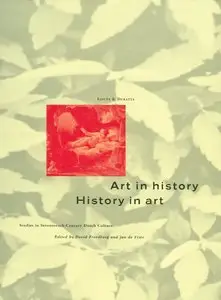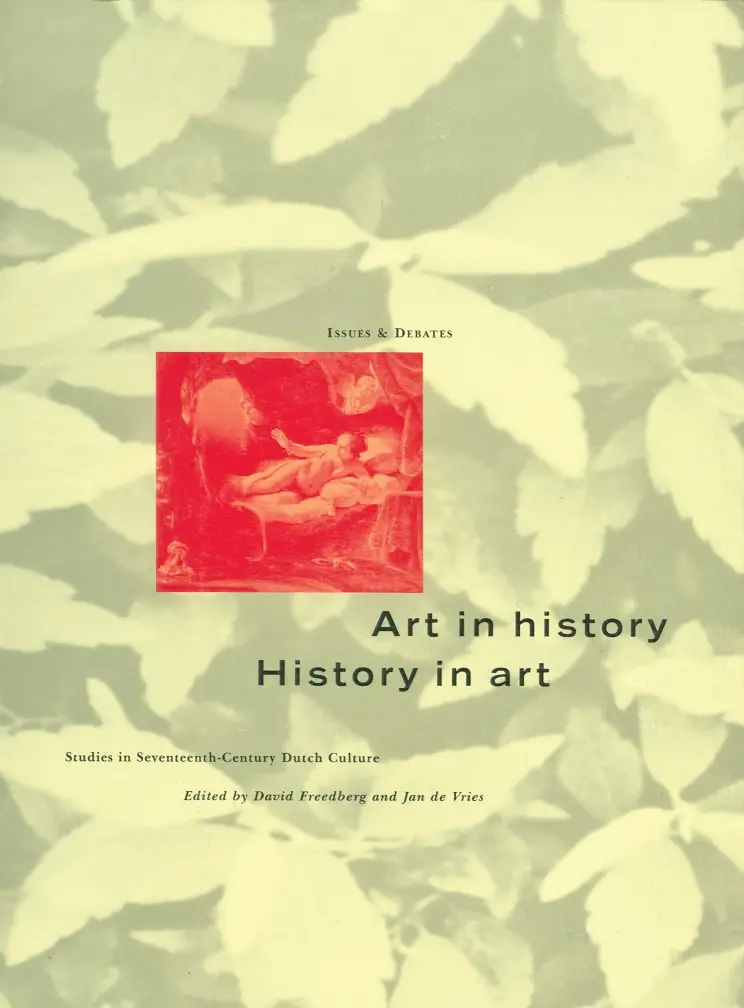David Freedberg, Jan de Vries, "Art in History/History in Art: Studies in Seventeenth-Century Dutch Culture"
Publisher: J. Paul Getty | 1991 | ISBN: 0892362006 | English | PDF | 456 pages | 55.8 Mb
Publisher: J. Paul Getty | 1991 | ISBN: 0892362006 | English | PDF | 456 pages | 55.8 Mb
Art in History/History in Art considers the potential for a reciprocally illuminating relationship between art history and history in light of recent methodological developments in both fields. The volume opens with contributions from a historian and an art historian; they examine the weaknesses of an art history without a social or economic history and lay the groundwork for the ensuing discussions of how the procedures and methods of each discipline may serve the aims of the other. A wide critique of approaches to the interpretation of realism in Dutch pictures forms the second section of the book. Included are critical views of recent iconographic developments, as well as contributions by a plant taxidermist and a marine historian. In the volume’s third section, new statistical and numerical models for the study of Dutch art in Dutch society are presented by three economic historians. The concluding essay provides a constructive critique of existing methodologies within each field. The volume offers the most secure basis to date for future work on the interaction between the two disciplines and between the content of pictures and the cultures that produce them.
Los Angeles is a city on the Pacific Rim where things appear on edge, for they lack a permanent footing even while occupying a specific locale. The city’s genius loci produce this dual vision of fixed place in a state of constant dislocation.
It is only appropriate for the edge-bound Getty Center to initiate a series of publications that aim to expose the historical study of artifacts to the oscillation of rigorous debate. Each of these books proceeds from a specific body of historical material, not because that material is in itself inherently imbued with controversy but because its exposure to different disciplinary approaches raises new questions of interpretation. In the realm of historical studies, issues often emerge at the intersection of the various perspectives scholars have constructed for the examination of their subjects. As their debate refracts and refocuses the material under scrutiny, it also invites reflection upon itself and thereby exposes the assumptions and tendencies of scholarship to no less assiduous criticism than it does the underpinnings of its subjects.
Volumes in the Issues & Debates series will result from symposia and lecture series, as well as from commissioned writings. Their scholarly editors are invited to frame highly focused essays with introductions, commentaries and/or sources, documents, and illustrations that further contribute to their usefulness.
Introduction
Introduction
Jan de Vries
Art in History
Gary Schwartz
History in Art
J. W. Smit
Part I: Art and Reality
Market Scenes As Viewed by an Art Historian
Linda Stone-Ferrier
Market Scenes As Viewed by a Plant Biologist
Willem A. Brandenburg
Marine Paintings and the History of Shipbuilding
Richard W. Unger
Skies and Reality in Dutch Landscape
John Walsh
Some Notes on Interpretation
E. de Jongh
Are These Girls Really So Neat? On Kitchen Scenes and Method
Jochen Becker
Didactic and Disguised Meanings? Several Seventeenth-Century Texts on Painting and the Iconological Approach to Northern Dutch Paintings of This Period
Eric J. Sluijter
The Changing Face of Realism
Lyckle de Vries
Part II: Art, Economy, and Society
Art History
Jan de Vries
The Volume and Value of Paintings in Holland at the Time of the Dutch Republic
Ad van der Woude
Works of Art in Seventeenth-Century Amsterdam: An Analysis of Subjects and Attributions
John Michael Montias
Conclusion
Science, Commerce, and Art: Neglected Topics at the Junction of History and Art History
David Freedberg
Biographical Notes on the Authors
Index
Introduction
Jan de Vries
Art in History
Gary Schwartz
History in Art
J. W. Smit
Part I: Art and Reality
Market Scenes As Viewed by an Art Historian
Linda Stone-Ferrier
Market Scenes As Viewed by a Plant Biologist
Willem A. Brandenburg
Marine Paintings and the History of Shipbuilding
Richard W. Unger
Skies and Reality in Dutch Landscape
John Walsh
Some Notes on Interpretation
E. de Jongh
Are These Girls Really So Neat? On Kitchen Scenes and Method
Jochen Becker
Didactic and Disguised Meanings? Several Seventeenth-Century Texts on Painting and the Iconological Approach to Northern Dutch Paintings of This Period
Eric J. Sluijter
The Changing Face of Realism
Lyckle de Vries
Part II: Art, Economy, and Society
Art History
Jan de Vries
The Volume and Value of Paintings in Holland at the Time of the Dutch Republic
Ad van der Woude
Works of Art in Seventeenth-Century Amsterdam: An Analysis of Subjects and Attributions
John Michael Montias
Conclusion
Science, Commerce, and Art: Neglected Topics at the Junction of History and Art History
David Freedberg
Biographical Notes on the Authors
Index
“There are some very stimulating essays in this book, which anyone interested in seventeenth-century Dutch art will want to explore.” —Burlington Magazine
Jochen Becker focuses his research on the interrelation of art and literature, iconology, art theory, and emblematics. He teaches iconology and art theory at the Rijksuniversiteit, Utrecht.
Willem A. Brandenburg studies the backgrounds of cultivated plants and their mechanisms of domestication. He pursues his research as a plant systematist at the Centre for Variety Research and Seed Technology (CRZ), Wageningen.
David Freedberg focuses his research on art theory and the history of Dutch, Flemish, and Italian art. He is a professor of art history at Columbia University, New York.
E. de Jongh specializes in iconology and art theory. From 1976 until his retirement in 1990, he was a professor of art history at the Rijksuniversiteit, Utrecht.
John Michael Montias engages in research ranging from trade in art goods in seventeenth-century Holland to industrial policy in contemporary Eastern Europe. He is a professor of economics at Yale University, New Haven.
Gary Schwartz focuses his studies on Dutch art history. He is the publisher of Gary Schwartz/SDU, an imprint of SDU, the former Dutch Government Publishing Office.
Eric J. Sluijter specializes in Dutch art history. He is an associate professor at the Rijksuniversiteit, Leiden.
J. W. Smit studies the social structure and cultural history of the Dutch Republic. He is Queen Wilhelmina Professor of History and Literature of the Low Countries at Columbia University, New York.
Linda Stone-Ferrier focuses her research on Dutch art history. She is an associate professor of art history at the University of Kansas, Lawrence.
Richard W. Unger studies marine history. He is a professor of history at the University of British Columbia, Vancouver.
Jan de Vries studies European preindustrial economies and the historical process of Europe’s urbanization. He is a professor of history and economics at the University of California, Berkeley.
Lyckle de Vries researches problems of periodization and classification in Dutch art. He teaches art history at the Rijksuniversiteit, Groningen.
John Walsh specializes in the study of seventeenth-century Dutch painting. He is the former director of the J. Paul Getty Museum.
Ad van der Woude researches issues in Dutch economic history. He is a professor in the Department of Rural History at Wageningen Agricultural University.
Willem A. Brandenburg studies the backgrounds of cultivated plants and their mechanisms of domestication. He pursues his research as a plant systematist at the Centre for Variety Research and Seed Technology (CRZ), Wageningen.
David Freedberg focuses his research on art theory and the history of Dutch, Flemish, and Italian art. He is a professor of art history at Columbia University, New York.
E. de Jongh specializes in iconology and art theory. From 1976 until his retirement in 1990, he was a professor of art history at the Rijksuniversiteit, Utrecht.
John Michael Montias engages in research ranging from trade in art goods in seventeenth-century Holland to industrial policy in contemporary Eastern Europe. He is a professor of economics at Yale University, New Haven.
Gary Schwartz focuses his studies on Dutch art history. He is the publisher of Gary Schwartz/SDU, an imprint of SDU, the former Dutch Government Publishing Office.
Eric J. Sluijter specializes in Dutch art history. He is an associate professor at the Rijksuniversiteit, Leiden.
J. W. Smit studies the social structure and cultural history of the Dutch Republic. He is Queen Wilhelmina Professor of History and Literature of the Low Countries at Columbia University, New York.
Linda Stone-Ferrier focuses her research on Dutch art history. She is an associate professor of art history at the University of Kansas, Lawrence.
Richard W. Unger studies marine history. He is a professor of history at the University of British Columbia, Vancouver.
Jan de Vries studies European preindustrial economies and the historical process of Europe’s urbanization. He is a professor of history and economics at the University of California, Berkeley.
Lyckle de Vries researches problems of periodization and classification in Dutch art. He teaches art history at the Rijksuniversiteit, Groningen.
John Walsh specializes in the study of seventeenth-century Dutch painting. He is the former director of the J. Paul Getty Museum.
Ad van der Woude researches issues in Dutch economic history. He is a professor in the Department of Rural History at Wageningen Agricultural University.





